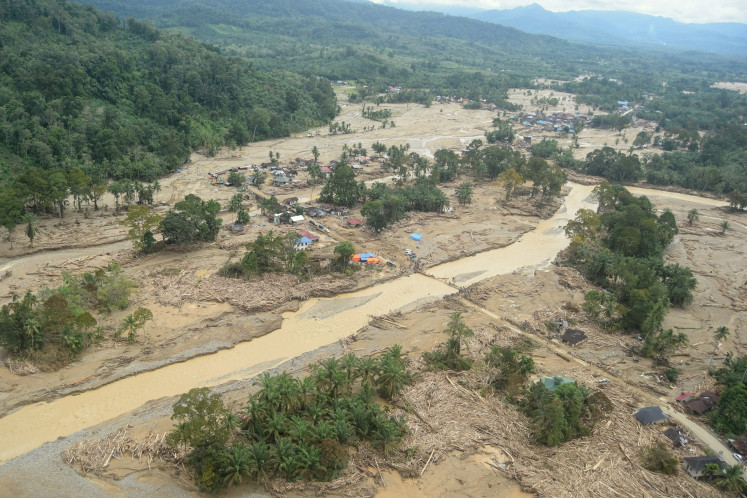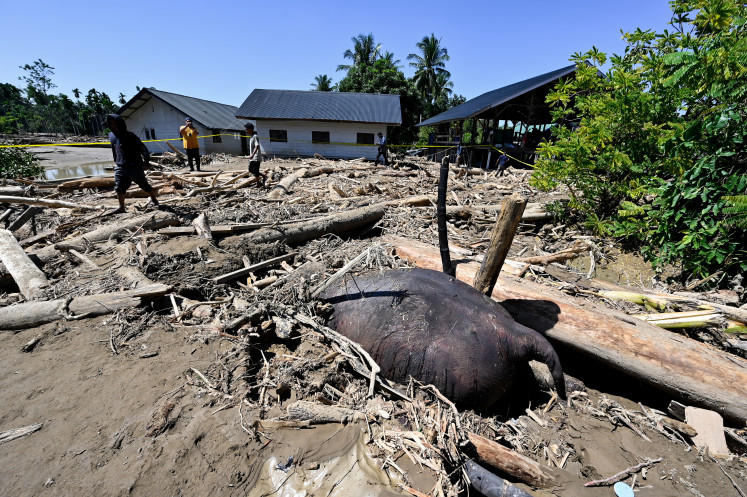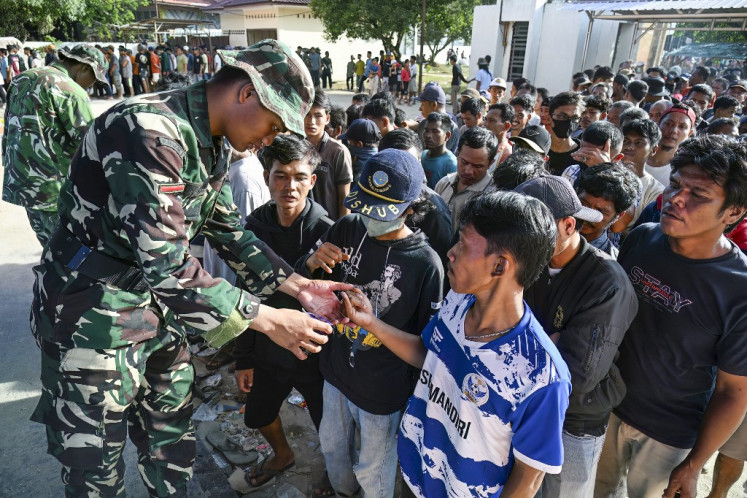Popular Reads
Top Results
Can't find what you're looking for?
View all search resultsPopular Reads
Top Results
Can't find what you're looking for?
View all search resultsInept officials, database slow efforts to curb water crisis
Common pool: A local resident bathes his water buffalo in the Wilangung River, Undaan district, Kudus regency, Central Java, on Wednesday, with the dried-up Wilalung Dam behind him
Change text size
Gift Premium Articles
to Anyone
 Common pool: A local resident bathes his water buffalo in the Wilangung River, Undaan district, Kudus regency, Central Java, on Wednesday, with the dried-up Wilalung Dam behind him. During the past couple of months, local residents have come to the river to take a bath or wash their clothes after their wells dried up due to the prolonged dry season.(JP/Suherdjoko) (JP/Suherdjoko)
Common pool: A local resident bathes his water buffalo in the Wilangung River, Undaan district, Kudus regency, Central Java, on Wednesday, with the dried-up Wilalung Dam behind him. During the past couple of months, local residents have come to the river to take a bath or wash their clothes after their wells dried up due to the prolonged dry season.(JP/Suherdjoko) (JP/Suherdjoko)
C
span class="caption">Common pool: A local resident bathes his water buffalo in the Wilangung River, Undaan district, Kudus regency, Central Java, on Wednesday, with the dried-up Wilalung Dam behind him. During the past couple of months, local residents have come to the river to take a bath or wash their clothes after their wells dried up due to the prolonged dry season.(JP/Suherdjoko)
Despite the worsening impacts of this year's prolonged dry season, a lack of coordination among local officials has slowed the government's efforts to provide assistance for farmers and residents in the country's worst-hit regions.
In Gorontalo city, a recent coordination meeting involving officials from Gorontalo province's six regions heated up after some of the participants disagreed about the extent of the impact of the prolonged dry season on the province.
An official from Bone Bolango's Agriculture Agency, for example, reported that 1,081 hectares of corn fields in the regency had suffered from drought over the past few weeks. An official from the province's Pest Control and Plant Protection Agency (BPTPH), meanwhile, insisted that drought had hit only 31 ha of corn fields in the regency.
During the meeting, held on Tuesday at one of the city's biggest hotels, both officials insisted that their respective data was valid and up-to-date.
Gorontalo province's Agriculture Agency head Muljady Mario admitted that many basic statistics on the agriculture sector submitted by local agencies did not match when compared. 'This meeting is aimed at examining all that data, to find out which is valid,' Muljady said.
Muljady said the Tuesday meeting was critical as the administration needed to know which parts of the region had been worst hit by drought and needed immediate assistance.
'The agency actually has 54 water pumps; each of them has a capacity of between 15 and 20 liters per second. However, we still don't know which areas experienced drought and whether water can still be pumped out there,' he said.
Last week, the Public Works and Public Housing Ministry confirmed that over 9,000 ha of rice fields in six provinces, including South Sulawesi, Central Java and East Java, have experienced harvest failure over the past few months due to a prolonged dry season caused by the El Niño weather phenomenon.
While the dry season in Indonesia normally occurs from April to September, El Niño has been predicted to extend the dry season until the end of the year.
Despite the long absence of rain in most parts of the country, Agriculture Minister Amran Sulaiman said on Tuesday that the prolonged dry season would not significantly disrupt the country's target of increasing its rice production this year. The ministry, he said, had also taken many anticipative measures, including developing tertiary irrigation for 1.3 million ha of crop fields and distributing 40,000 units of agricultural equipment and machines.
Many farmers, however, said they had yet to feel the impacts of such policies.
Amin Polingala, who grows mustard greens in Tilango district, Gorontalo regency, said he was now relying on a small-capacity water pump to water his vegetables. Last month, he had to spend extra money to buy 30 liters of gasoline to operate the pump.
'What else can I do?' he said.
Meanwhile, in Kudus, Central Java, residents in Kalirejo subdistrict have been forced to wash in rivers ' where buffaloes are also bathed ' as wells and other water resources have recently dried up.
'For cooking and drinking, we must spend Rp 3,000 [22 US cents] to buy 40 liters of clean water,' Yuyun, a local resident, said.
Also in Central Java, the Wonogiri Disaster Mitigation Agency (BPBD) has continued to distribute clean water to areas in the southern part of the regency that have been struggling with severe water shortages. BPBD head Bambang Haryanto said 207 tanks with a capacity of 6,000 liters had been readied for the task.









